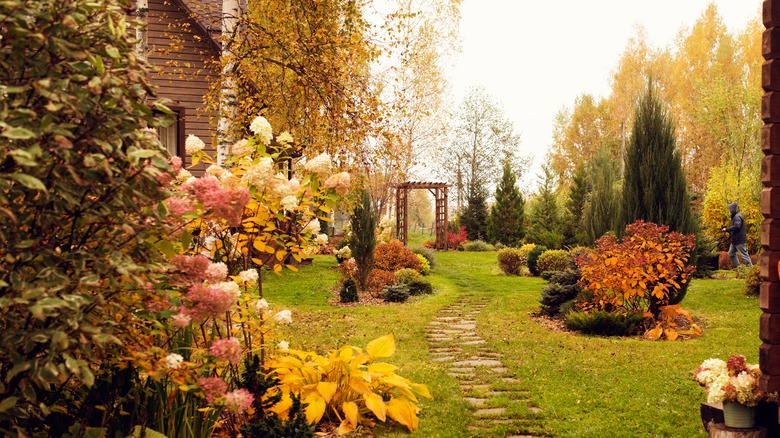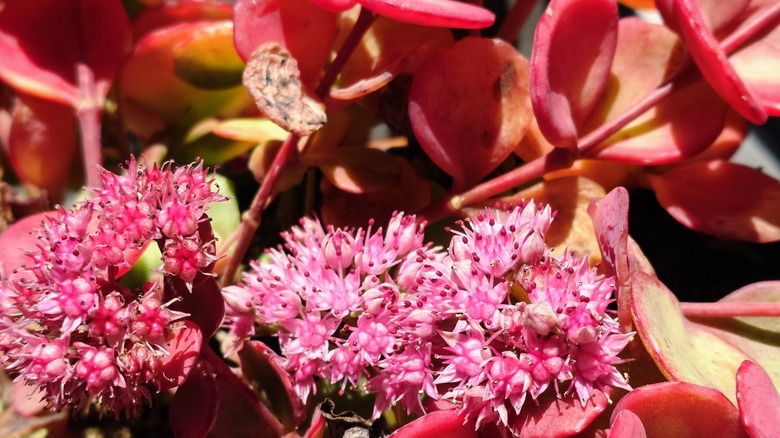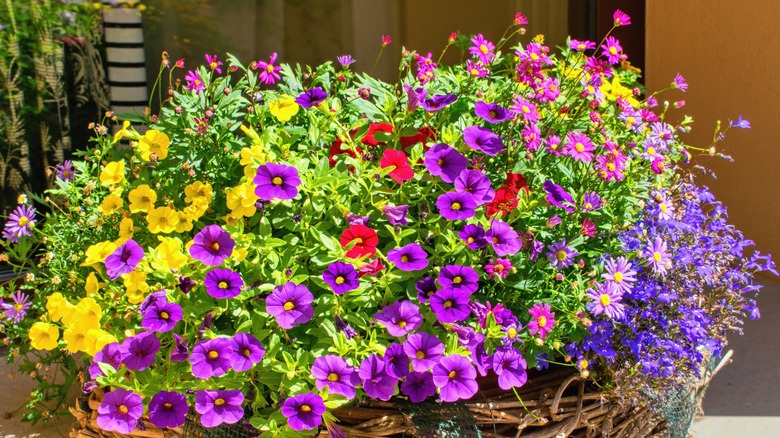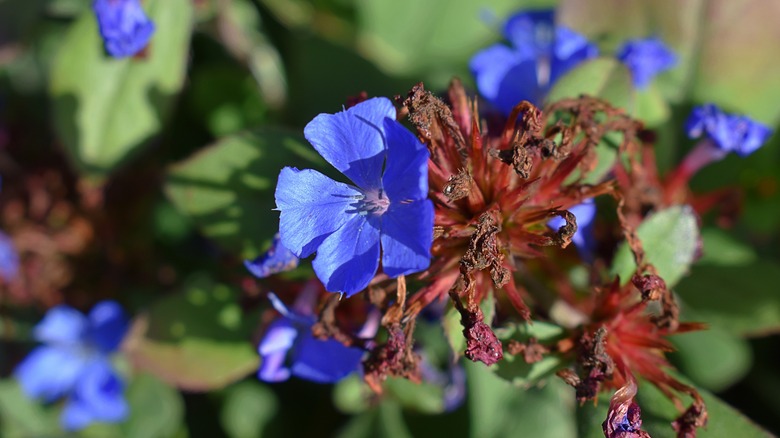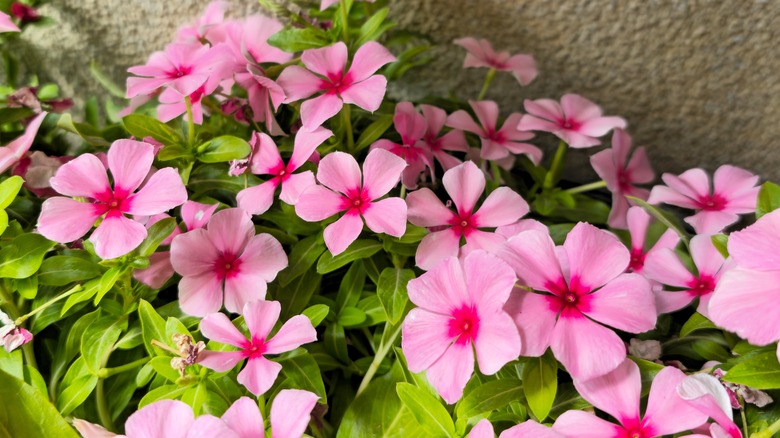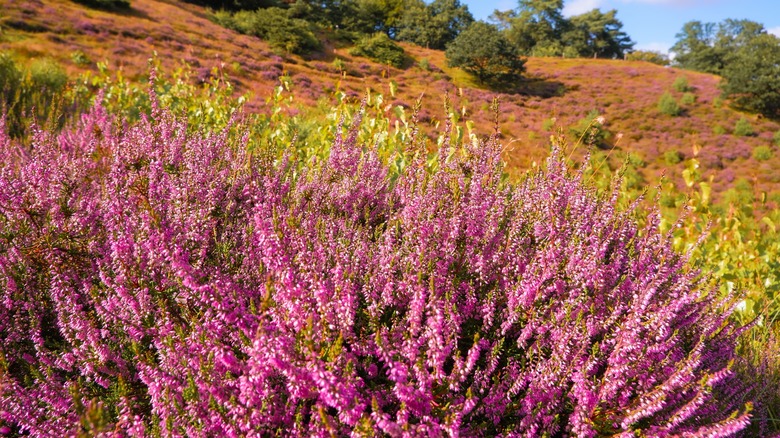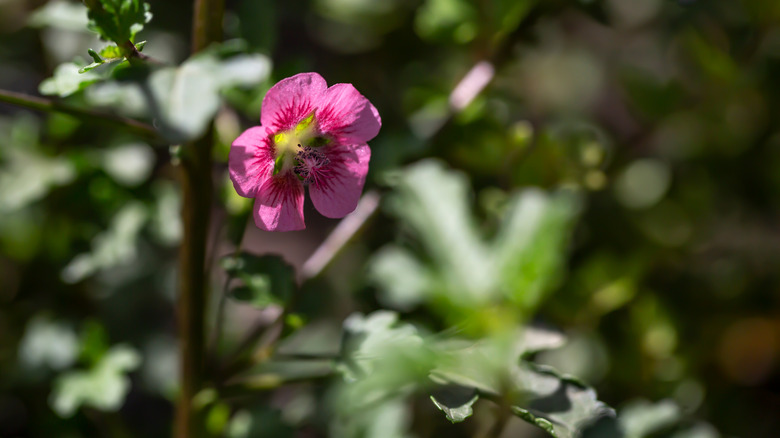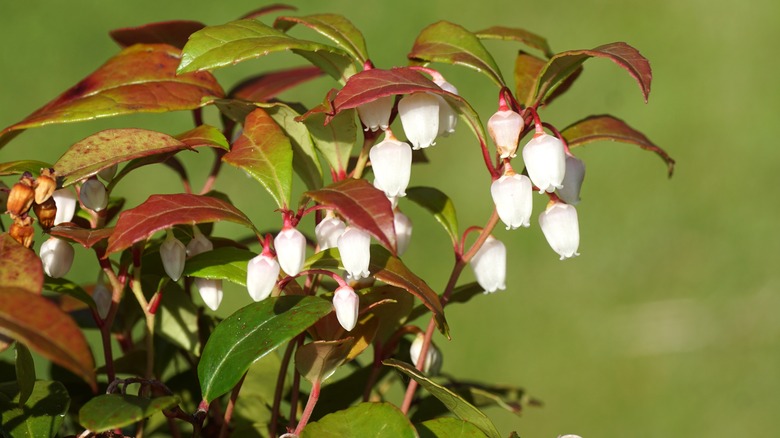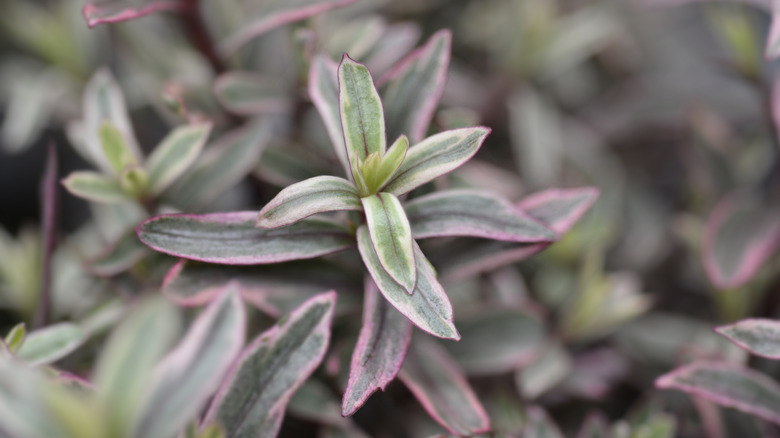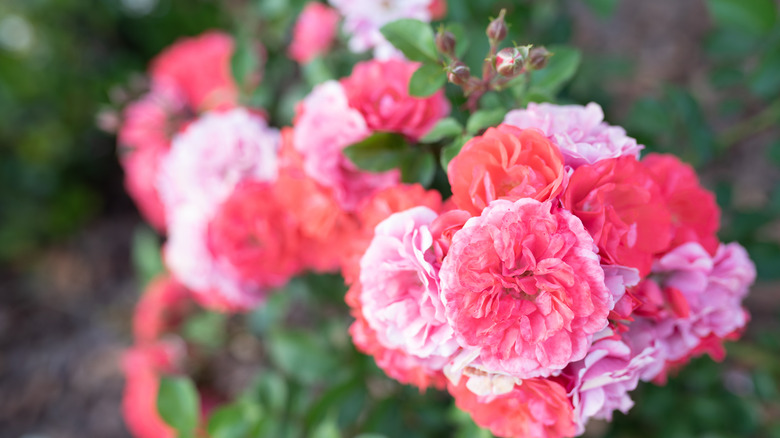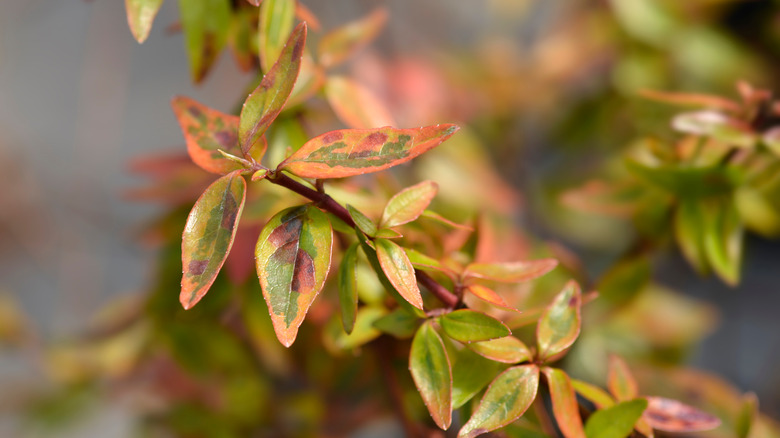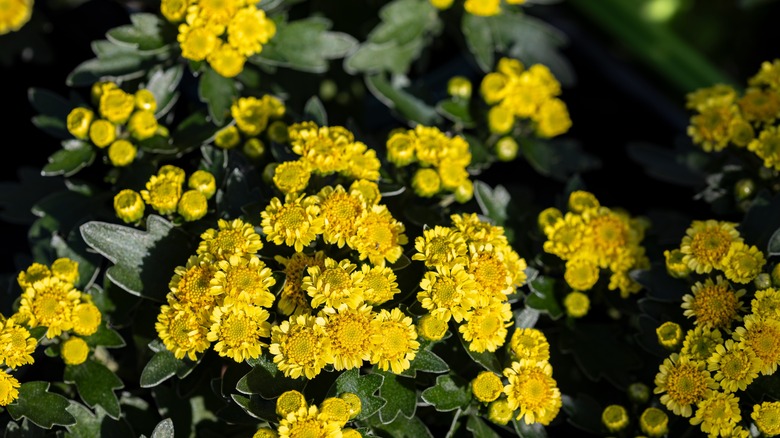The Best Late Season Ground Cover Plants For A Colorful Landscape
We may receive a commission on purchases made from links.
Who says spring and summer-blooming plants are the only ones that get all the fun? Sure, they may give you beautiful bursts of colorful flowers, but they're usually MIA once fall months hit. Luckily, there are ground cover plants that keep the party going well into fall, giving one last burst of color before being buried in the snow.
We've rounded up 11 breathtaking landscape plants, from the pink and orange blooms of 'Coral Drift' rose to the purple-tinged leaves of 'Frozen Flame' hebe, that put on one final show during the cooler autumn months. These plants not only look amazing, but their low profile allows them to work as game-changing ground covers, suppressing weeds and covering bare patches that were possibly left by earlier blooming flowers or failed landscape experiments (we understand and sympathize).
Japanese stonecrop goes from blue-green to bright reds and pinks in the fall
Got a spot in your yard that gets good sun, but has weird soil that makes it tough for things to grow? Give the Japanese stonecrop (Hylotelephium sieboldii) a try. It's a hardy succulent often used as a ground cover that can handle sandy soils, rocky landscapes, and is even used for xeriscaping. But the best part is its year-long color change abilities. During the spring, Japanese stonecrop looks like your garden variety succulent with blue-green leaves. However, as the temperature heats up, the leaves begin to develop pink edges that give it a really dynamic look. But wait until fall rolls around for the big display; Japanese stonecrop's leaves turn into a striking red-orange color that complements its hot pink blooms.
Japanese stonecrop isn't super picky about its setup, as long as the soil has a neutral or slightly alkaline pH. Since it is a succulent, it won't do well in areas that have heavy moisture in the soil, so keep it where things tend to stay on the drier side. It can handle full sun and partial shade, but shadier conditions will make the plant look pretty sad and droopy. Japanese stonecrop is a perennial, but some gardeners like to take cuttings of it to propagate during the winter, just in case, since it makes an excellent container plant, too. If you decide to pop it in a pot, be sure to use a soil blend that's well-draining (Miracle-Gro's Succulent Potting Mix is pretty popular) and let the soil dry out before giving the plant another drink.
Million bells will flower from summer until first frost
Million bells (Calibrachoa x hybrida) may look like a delicate, spring blooming petunia, but it's literally a late bloomer that gardeners love for adding one last pop of brilliant color to their gardens. Million bells stay low to the ground and spread nearly 2 feet, giving a dense mat of foliage. Once the summer temperature hits, million bells will begin to bloom in a variety of colors — from red to yellow to purple — that don't stop until the first frost. Plus, they're incredibly low maintenance and don't need deadheading to rebloom; they've got it covered on their own, thanks.
Caring for million bells is pretty easy as they can live in partial shade, but need full sun to produce the most flowers. They grow best in soil that's moist but well-draining and full of organic materials. Blooming for months on end takes a lot of energy, so million bells needs a slow-release fertilizer treatment every now and then to give it the sustenance it needs to keep on keepin' on. Osmocote Smart-Release Plant Food Plus has been around forever and is a popular option, but any well-balanced fertilizer that gives a consistent, steady release of nutrients should work fine.
Hardy plumbago takes over when other plants die back
Do you want a show-stopping ground cover for your landscape? Look no further than the hardy plumbago (Ceratostigma plumbaginoides). This low-growing plant starts with green leaves, but over time, the foliage begins to develop a red tinge to it. By the time fall hits, the leaves are on full display with bright red hues that make an incredible backdrop for its bright blue flowers, which resemble phlox. The bright red and blue hues will make a gorgeous contrast to your landscape, especially when filling in bare spots left by earlier-blooming annuals.
Hardy plumbago has a, well, hardy root system that some would consider to be aggressive, so don't put it near plants that hate having their roots disturbed. For instance, it would be a mistake to plant them next to gardenias. That hardy root system allows it to handle most soil conditions, including soil low on nutrients. It can spread freely, but isn't considered invasive, so put it somewhere that's historically been challenging to plant around, like rocks or under trees. Hardy plumbago needs a little shade during the mid-afternoon summer sun, but if you're choosing between two locations, pick the sunnier spot for better color contrasts.
Madagascar periwinkle blooms until the first frost
Is there anything prettier than the dainty Madagascar periwinkle (Catharanthus roseus)? Its delicate pink flowers look like they'd be a shrinking violet without growing conditions that are just so, but this plant is tougher than it looks. Madagascar periwinkle displays pink blooms repeatedly from July through September, and may even go longer, depending on when your first frost hits. It's so hardy that gardeners have reported it'll even push out new blooms during the height of harsh summer temperatures. This plant is on a mission to bloom, and nothing's going to get in its way.
Madagascar periwinkle likes full sun, but can handle a little shade here and there. It really likes acidic soil pH levels, but will tolerate a neutral pH just fine, if that's what you've got, so long as the soil stays moist, but is well-draining. If you're in USDA Zone 10, then you're one of the few lucky ones who can expect this plant to be a perennial. As for the rest of us, we'll have to use the months we have together with this plant wisely and buy a new round of annuals next year.
Scotch heather makes an excellent fall ground cover for poor soil areas
Are you willing to put in a little work in order to be rewarded with gorgeous pops of color in your fall yard? Then consider the Scotch heather (Calluna vulgaris), a bushier groundcover with sprigs full of pink and purple-colored flowers. There are over 1,000 cultivars of the Scotch heather, so, of course, we knew there just had to be autumn blooming options. Luckily, we found over a dozen cultivars that will give you a stunning show in the fall, with colors ranging from bronzy-gold and red to muted silver and yellow. If you're heading to your local nursery, look for these fall foliage cultivars: Aurea, County Wicklow, Cuprea, Foxii Nana, H.E. Beale, J.H. Hamilton, Mairs Variety, Mrs. Pat, Mrs. Ronald Gray, Nana Compacta, Plena Multiplex, Searlei Aurea, Sister Anne, Tomentosa.
Scotch heather plants need full sun and well-draining soil that's on the acidic side. It can handle soil with low nutrients, but add a little organic material around it so your heather has something to draw nutrients from. Scotch heather cannot handle too much nitrogen, so make sure to get a soil test first so you don't waste your money. This plant is probably not suited for beginning gardeners, because it's pretty finicky about its water intake and can't handle too much or too little watering. Still, if you get its conditions just right, this plant is sure to give you a beautiful display in that golden autumn sun.
Pink mallow makes a beautiful ground cover that could bloom all year long
While Scotch heather needs some care management to make it happy, the pink mallow (Anisodontea scabrosa) is quite the opposite. This easygoing ground cover is a proficient bloomer, churning out pink flowers from spring all the way until the first frost. Its bright pink flowers look like mini hibiscuses, and it's really good at self-regulating its flower production, so deadheading isn't necessary. Plus, once you've got it settled in, pink mallow becomes a multi-season favorite for pollinators like bees and butterflies.
Pink mallow needs full sun for the showiest flowers and doesn't really care about what soil conditions it's planted in; it just has to be well-draining. Give it some water once you've got it in the ground, but back off once its settled; pink mallow won't need much and is known for being one of the best drought-tolerant ground covers around. Pink mallow is a perennial, but really harsh winters can make it hard for your plant to come back. If your area is susceptible to bitter winters, first, our sincerest sympathies, but also, consider mulching over your plant in late summer or wrapping it up to protect it from the rough weather.
American wintergreen thrives in shady landscapes
If you think about it, it makes sense that so many late-blooming ground covers would want full-sun conditions. The fewer hours of sunlight mean they have limited time to soak up everything they need for photosynthesis, so the more light, the better. However, not all fall-blooming plants want to stay in the light and would much rather stay nice and cozy in the shade. The American wintergreen (Gaultheria procumbens) is one of those — a pretty little ground cover that loves the shade. During the fall, its leaves go from green to a bronzy-copper color that looks amazing next to its pretty, white bell flowers and bright red berries.
American wintergreen leaves will give off its namesake scent when crushed and were sometimes used to flavor chewing gum, making it a good ground cover for sensory gardens and as a natural pest repellent for rats. Gaultheria procumbens comes from the blueberry family, so it needs acidic soil that's moist, but well-draining. It prefers being planted in partial shade, but can handle heavy shade if needed; the color change just might not be as brilliant. Wintergreen is a slow-growing plant with a long lifespan, so be patient with it the first few years as it settles in.
'Frozen Flame' hebe turns into a deep purple during fall and winter
Hebes are little wonder shrubs. They're compact, hardy plants that can grow just about anywhere and would rather be left alone than doted on. The low-growing 'Frozen Flame' hebe (Veronica 'Frozen Flame') is just like its brethren, except it's a year-round favorite for gardeners. During the spring and summer, 'Frozen Flame' hebe will typically maintain a silvery-gray look to its leaves, focusing its effort on pushing out bright blue flowers in the summer months. But once the flowers are spent, this hebe's leaves will begin to have a slight pink tinge to them that eventually turns into a deep purple. Depending on the area, your frozen flame hebe could keep that color all winter long, too, until reverting back to its muted silver once the spring growing season has begun.
'Frozen Flame' hebe likes full sun, but can live in partial shade. It's an easygoing ground cover that likes a variety of soil conditions, handling loamy, chalky, or sandy soils pretty well. It needs neutral or slightly-alkaline pH levels and the area around it should stay moist, but be well-draining, so it doesn't sit in water for too long. Once established, 'Frozen Flame' hebe is drought-tolerant and can attract pollinators long after earlier blooming flowers have been spent.
'Coral Drift' rose is easygoing and blooms from spring until first frost
If you're a rose lover, then this is the ground cover you've been waiting for. The 'Coral Drift' Rose (Rosa Coral Drift 'MELdrifora') is a rose bush that grows low and out, instead of upright and bushy, producing clusters of pink or orange flowers repeatedly from spring until the first frost. Its dark green foliage is dense, too, making it a useful ground cover for bare patches in your landscape.
Despite having such a pretty appearance, 'Coral Drift' roses are not high maintenance. They will need slow-release fertilizer feedings in the spring and end of summer to give them enough energy for repeated blooms. Coral drift rose likes the sun on its flowers, so keep it somewhere that doesn't get a lot of shade. Well-draining soil that's rich with organic materials will help give this shrub the nutrients it needs for a long blooming season. This shrub is one of the taller ground covers, so it can handle being mulched around without succumbing to root rot from too much moisture.
'Kaleidoscope' abelia will give you a variety of colors all year
Sometimes a plant just tells you what it's all about right in its name, and this is one of them. The 'Kaleidoscope' abelia (Abelia x grandiflora 'Kaleidoscope') is like the Technicolor Dream Coat of the plant world. During the spring, its leaves start off with a light, slightly variegated green. As the seasons progress, the leaves begin to switch from green into bright bursts of red, orange, and yellow; all colors that only deepen throughout summer and fall. The color change is even more dramatic when paired with their dainty white or blush-pink flowers that tend to bloom early in the spring.
'Kaleidoscope' abelia is a low-spreading shrub that can grow up to 3 feet tall, so if you'd like to use it as a ground cover you'll need to keep its branches trimmed short. Abelias can handle sunny spots or areas with some shade, but probably wouldn't do well in too bright or too shady conditions. They need well-draining soil that's moist and has an acidic pH. Once it's become established, your 'Kaleidoscope' abelia can handle droughts like a champ and isn't interesting to most pests, including deer.
Silver and gold chrysanthemums will create clusters of golden blooms every fall
If you want something to mimic the golden hues of the autumnal sun, look no further than the silver and gold chrysanthemum (Ajania pacifica). Its silvery-green foliage looks unassuming enough, though they have a unique silver trim that's hard to miss. But once the fall kicks in, some plants produce an absolutely stunning rainbow of variegations on the leaves, topped off with clusters of golden-yellow flowers. However, the leaf variegation seems to be rare, as we've only seen a few pictures of it, but we still love this ground cover for the buttery-yellow blooms that give your garden one last floral display — consider any leaf change a happy surprise.
To make your silver and gold chrysanthemum happy, you'll need to plant it in a spot with full sun. Partial shade is okay, but expect fewer blooms as the seasons progress. Ajania pacficia isn't very picky about the type of soil or its pH level, just make sure it's well-draining, as its low-growing bushiness becomes problematic and prone to rot if it's consistently moist. This ground cover is fairly drought-tolerant and tends to stick around for years, making it an excellent choice for someone who wants a beautiful landscape throughout the entire year.
